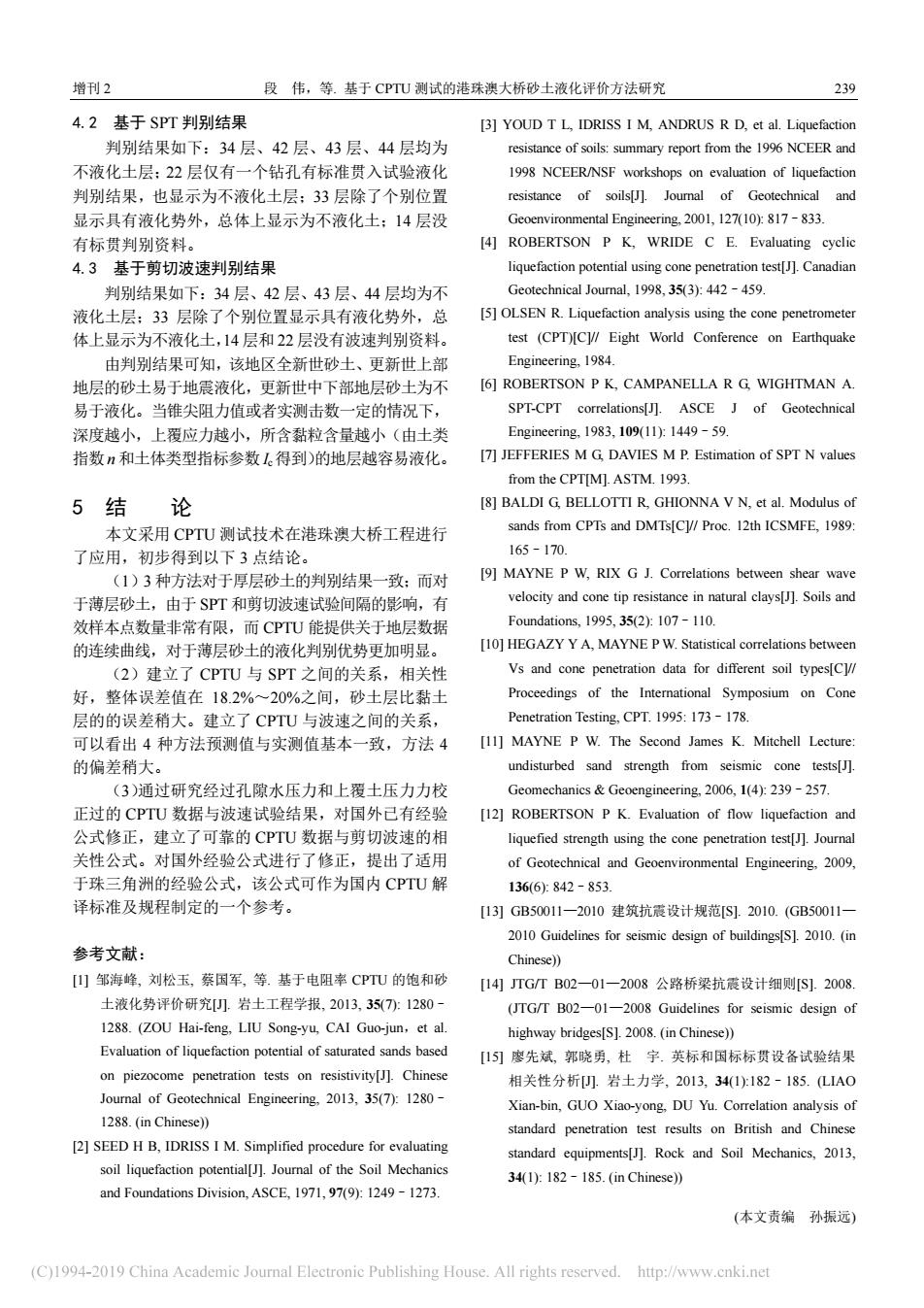正在加载图片...

增刊2 段伟,等。基于CPTU测试的港珠澳大桥砂土液化评价方法研究 239 4.2基于SPT判别结果 [3]YOUD TL IDRISS I M.ANDRUS R D.et al.Liquefaction 判别结果如下:34层、42层、43层、44层均为 resistance of soils:summary report from the 1996 NCEER and 不液化土层:22层仅有一个钻孔有标准贯入试验液化 998 NCEER/NSE wotkshons on evaluation of liquefaction 判别结果,也显示为不液化 土层:33层除了个别位置 显示具有液化势外,总体上显示为不液化土:14层没 2710817-833 有标贯判别资料。 [4] 4,3基于剪切波速判别结果 liquefaction potential using penetration test Canadian 判别结果如下:34层、42层、43层、44层均为不 Geotechnical Journal.1998.35(3):442-459. [5]OLSEN R.Liquefaction analysis using the cone penetrometer 体上显 为 test (CPTC Eight World Conference on Earthquake 由判别结果可知,该地区全新世砂土、更新世上部 eerine 1984 地层的砂土易于地震液化,更新世中下部地层砂土为不 [6]ROBERTSON P K.CAMPANELLA R G WIGHTMAN A 易于液化。当锥尖阻力值或者实测击数一定的情况下, SPT-CPT correlations[J].ASCE J of Geotechnical 深度越小,上覆应力越小,所含黏粒含量越小(由土类 ngineering,1983,10911449-59 指激n和士体类型指标参数得到)的地层越容易液化。 [7]JEFFERIES M G DAVIES M P.Estimation of SPT N values from the CPTIML ASTM.1993. 5结 论 [8]BALDI G BELLOTTI R.GHIONNA V N.et al.Modulus of 本文采用CTU测试技术在港跌澳大桥工得讲行 sands from CPTs and DMTsICV/Proc.12th ICSMFE.1989 了应用,初步得到以下3点结论。 165-10 (1)3种方法对于厚层砂土的判别结果一致:而对 MAYNE PW.RIX G J.Correlations bet een shea wav 于薄层砂土,由于SPT和剪切波速试验间隔的影响,有 velocity and cone tip resistance in natural clays Soils and 效样本点数量非常有限,而CPTU能提供关于 地层数 Foundations,1995,35(2):107-110. 的连续曲线, 势更加明显 [10]HEGAZY Y A.MAYNE P W.Statistical correlations between 建立 J与SPT之 间的 长系,相关 Vs and cone penetration data for different soil types[Cl/ 好,整体误差值在182%一20%之间,砂土层比黏士 层的的误差稍大。建立了CPTU与被速之间的关系, Testi CPT195:173-178 可以看出4种方法预测值与实测值基本一致,方法4 [MAYNE P W.The Second James K.Mitchell Lecture 的偏差稍大。 undisturbed sand strength from seismic cone tests (3)通过研究经过孔隙水压力和上覆土压力力校 Geomechanics&Geoengineering.2006,1(4):239-257. 正过的CPTU数据与波速试验结果,对国外己有经验 121 ROBERTSON P K.Evaluation of flow liguefaction and 公式修正,.建立了可党的CpT!数据与前切波速的相 关性公式。对国外经验公式进行了修正 提出了适用 干珠三角洲的名 of Geotechnical and Geoenvironmental Engineering.2009 该公式可作为国内CTU解 1366842-853. 译标准及规程制定的 个参考 I13引GB50011一2010建筑抗震设计规范S12010.4GB50011 2010 Guidelines for seismic design of buildings/S].2010.(in 参考文献: Chinese)》 I1邹海蜂,刘松玉,蔡国军,等.基于电阻者CPU的饱和砂 【14TGTB02-01一2008公路桥梁抗设计细则S1.20 土液化势评价研究岩土工程学报,2013,357)1280 (JTG/T B02-01-2008 Guidelines for seismic design of 1288.(ZOU Hai-fe ng-yu,CAI Gu highway bridgesIS1.2008.(in Chinese)) 山)廖先斌,郭晓勇,杜宇.英标和国标标贯设备试验结果 on piezocome penetration tests on resistivityJ.Chinese 相关性分析几.岩土力学.2013.341上182-185.L1A0 Joural of Geotechnical Engineering.2013.35(7):1280 Xian-bin,GUO Xiao-yong.DU Yu. 1288.(in Chinese)) standard penetration test results on British and Chinese [21 SEED H B.IDRISS I M.Simplified procedure for evaluatin standard equipments[J].Rock and Soil Mechanics,2013, soil liquefaction potential Joumal of the Soil Mechanics 34(1):182-185.(in Chinese)) and Foundations Division.ASCE,():1249-1273. (本文责编孙振远) C)1994-2019 China Academic Journal Electronic Publishing House.All rights reserved. http://www.cnki.net 增刊 2 段 伟,等. 基于 CPTU 测试的港珠澳大桥砂土液化评价方法研究 239 4.2 基于 SPT 判别结果 判别结果如下:34 层、42 层、43 层、44 层均为 不液化土层;22 层仅有一个钻孔有标准贯入试验液化 判别结果,也显示为不液化土层;33 层除了个别位置 显示具有液化势外,总体上显示为不液化土;14 层没 有标贯判别资料。 4.3 基于剪切波速判别结果 判别结果如下:34 层、42 层、43 层、44 层均为不 液化土层;33 层除了个别位置显示具有液化势外,总 体上显示为不液化土,14 层和 22 层没有波速判别资料。 由判别结果可知,该地区全新世砂土、更新世上部 地层的砂土易于地震液化,更新世中下部地层砂土为不 易于液化。当锥尖阻力值或者实测击数一定的情况下, 深度越小,上覆应力越小,所含黏粒含量越小(由土类 指数n 和土体类型指标参数Ic得到)的地层越容易液化。 5 结 论 本文采用 CPTU 测试技术在港珠澳大桥工程进行 了应用,初步得到以下 3 点结论。 (1)3 种方法对于厚层砂土的判别结果一致;而对 于薄层砂土,由于 SPT 和剪切波速试验间隔的影响,有 效样本点数量非常有限,而 CPTU 能提供关于地层数据 的连续曲线,对于薄层砂土的液化判别优势更加明显。 (2)建立了 CPTU 与 SPT 之间的关系,相关性 好,整体误差值在 18.2%~20%之间,砂土层比黏土 层的的误差稍大。建立了 CPTU 与波速之间的关系, 可以看出 4 种方法预测值与实测值基本一致,方法 4 的偏差稍大。 (3)通过研究经过孔隙水压力和上覆土压力力校 正过的 CPTU 数据与波速试验结果,对国外已有经验 公式修正,建立了可靠的 CPTU 数据与剪切波速的相 关性公式。对国外经验公式进行了修正,提出了适用 于珠三角洲的经验公式,该公式可作为国内 CPTU 解 译标准及规程制定的一个参考。 参考文献: [1] 邹海峰, 刘松玉, 蔡国军, 等. 基于电阻率 CPTU 的饱和砂 土液化势评价研究[J]. 岩土工程学报, 2013, 35(7): 1280– 1288. (ZOU Hai-feng, LIU Song-yu, CAI Guo-jun,et al. Evaluation of liquefaction potential of saturated sands based on piezocome penetration tests on resistivity[J]. Chinese Journal of Geotechnical Engineering, 2013, 35(7): 1280– 1288. (in Chinese)) [2] SEED H B, IDRISS I M. Simplified procedure for evaluating soil liquefaction potential[J]. Journal of the Soil Mechanics and Foundations Division, ASCE, 1971, 97(9): 1249–1273. [3] YOUD T L, IDRISS I M, ANDRUS R D, et al. Liquefaction resistance of soils: summary report from the 1996 NCEER and 1998 NCEER/NSF workshops on evaluation of liquefaction resistance of soils[J]. Journal of Geotechnical and Geoenvironmental Engineering, 2001, 127(10): 817–833. [4] ROBERTSON P K, WRIDE C E. Evaluating cyclic liquefaction potential using cone penetration test[J]. Canadian Geotechnical Journal, 1998, 35(3): 442–459. [5] OLSEN R. Liquefaction analysis using the cone penetrometer test (CPT)[C]// Eight World Conference on Earthquake Engineering, 1984. [6] ROBERTSON P K, CAMPANELLA R G, WIGHTMAN A. SPT-CPT correlations[J]. ASCE J of Geotechnical Engineering, 1983, 109(11): 1449–59. [7] JEFFERIES M G, DAVIES M P. Estimation of SPT N values from the CPT[M]. ASTM. 1993. [8] BALDI G, BELLOTTI R, GHIONNA V N, et al. Modulus of sands from CPTs and DMTs[C]// Proc. 12th ICSMFE, 1989: 165–170. [9] MAYNE P W, RIX G J. Correlations between shear wave velocity and cone tip resistance in natural clays[J]. Soils and Foundations, 1995, 35(2): 107–110. [10] HEGAZY Y A, MAYNE P W. Statistical correlations between Vs and cone penetration data for different soil types[C]// Proceedings of the International Symposium on Cone Penetration Testing, CPT. 1995: 173–178. [11] MAYNE P W. The Second James K. Mitchell Lecture: undisturbed sand strength from seismic cone tests[J]. Geomechanics & Geoengineering, 2006, 1(4): 239–257. [12] ROBERTSON P K. Evaluation of flow liquefaction and liquefied strength using the cone penetration test[J]. Journal of Geotechnical and Geoenvironmental Engineering, 2009, 136(6): 842–853. [13] GB50011—2010 建筑抗震设计规范[S]. 2010. (GB50011— 2010 Guidelines for seismic design of buildings[S]. 2010. (in Chinese)) [14] JTG/T B02—01—2008 公路桥梁抗震设计细则[S]. 2008. (JTG/T B02—01—2008 Guidelines for seismic design of highway bridges[S]. 2008. (in Chinese)) [15] 廖先斌, 郭晓勇, 杜 宇. 英标和国标标贯设备试验结果 相关性分析[J]. 岩土力学, 2013, 34(1):182–185. (LIAO Xian-bin, GUO Xiao-yong, DU Yu. Correlation analysis of standard penetration test results on British and Chinese standard equipments[J]. Rock and Soil Mechanics, 2013, 34(1): 182–185. (in Chinese)) (本文责编 孙振远)